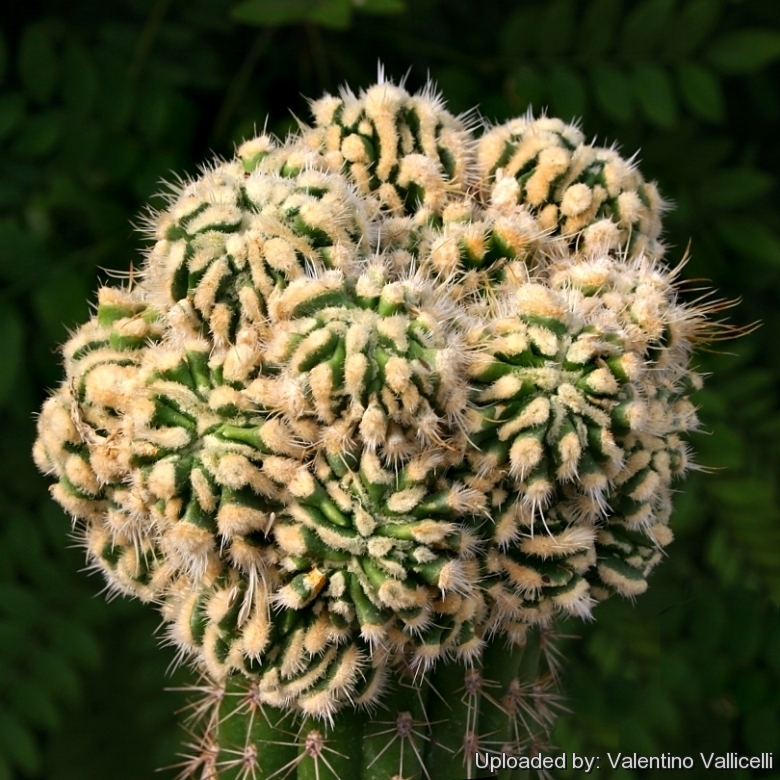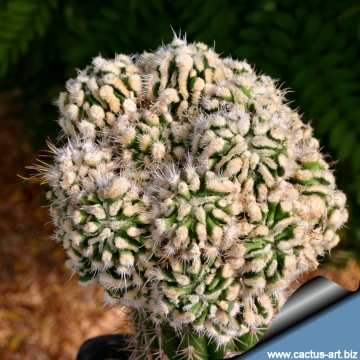Accepted Scientific Name: Stenocactus albatus f. mostruosus hort.

Echinofossulocactus albatus f. mostruosus (Stenocactus albatus f. mostruosus) Photo by: Valentino Vallicelli
Origin and Habitat: Garden origin (Nursery produced hybrid)
Synonyms:
See all synonyms of Stenocactus albatus
Description: Stenocactus albatusSN|6188]]SN|6188]] f. mostruosus is an odd monstrous plant with narrow felt-like areoles derived from the well known Stenocactus albatusSN|6188]]SN|6188]].
Habit: This cultivars is easily grown into crowded clumps or mounds, and tends to offset more abundantly than the normal form. Most plants will offset readily, and clumps can be produced in a few years.
Stem: Depressed-globose to somewhat elongated (depending on growing condition) 3-7 cm in diameter, green.
tubercles: Hatchet-shaped, laterally compressed.
Areoles: Very distinctive, creamy-white, conspicuous, in relief, extremely elongated, 5-12 mm long and 2-4 mm broad.
Spines: Short bristle-like white.
Flowers. Not seen.
Subspecies, varieties, forms and cultivars of plants belonging to the Stenocactus vaupelianus group
 Echinofossulocactus albatus f. mostruosus (Stenocactus albatus f. mostruosus) Photo by: Cactus Art
Echinofossulocactus albatus f. mostruosus (Stenocactus albatus f. mostruosus) Photo by: Cactus ArtSend a photo of this plant.The gallery now contains thousands of pictures, however it is possible to do even more. We are, of course, seeking photos of species not yet shown in the gallery but not only that, we are also looking for better pictures than those already present.
Read More... Cultivation and Propagation: It is relatively easy to grow on its own roots and quite resistant to cultivation. The only things that can kill this plant are cold and overwatering. Nevertheless, it is appropriate to provide adequate growing conditions in order to obtain compact plant with many flowers.
Soil: Use a an open and free draining mineral compost with little organic matter (peat, humus) that allows therefore roots to breath (as it is rot prone). Outdoors a well-draining rocky or sandy soil is ideal.
Pots: It needs a relatively shallow pot to accommodate its fibrous roots and provide a very good drainage. It may stay in the same pot for many years.
Watering: Needs regular water in summer. Keep rather dry in winter, tends to lose its roots in winter.
Fertilization: Feed with a high potassium fertilizer in summer during the growing season diluted to one-fourth potency and mix into the watering can for application.
Hardiness: Keep dry at 5- 10° C in winter, but can tolerate sporadic light frost if kept on the dry side prior to, and during, cold weather.
Exposition: The plant tolerates very bright situations, if kept too dark they may become overly lush and greener and could be prone to rotting due to over watering. Strong light encourages flowering and heavy wool and spine production, but is likely to suffer from sun scorch or stunted growth if over exposed to direct sunlight during the hottest part of the day in summer.
Pests & diseases: It may be attractive to a variety of insects, but plants in good condition should be nearly pest-free, particularly if they are grown in a mineral potting-mix, with good exposure and ventilation. Nonetheless, watch carefully for any significant decline in health. This may signal a pest problem that should be dealt with quickly in order to prevent scarring, stunting and even death.
- Red spiders: Red spiders may be effectively rubbed up by watering or misting the plants from above.
- Mealy bugs: Mealy bugs occasionally develop aerial into the new growth among the leaves with disfiguring results, but the worst types develop underground on the roots and are invisible except by their effects. Eliminate mealybug infestations by dabbing the critters with cotton swabs dipped in alcohol or by soaking the succulent's roots in a systemic insecticide.
- Scales: Scales are rarely a problem.
- Rot: This species is particularly easy and accommodating, seldom suffer of cryptogamic diseases. Rot it is only a minor problem with cacti if the plants are watered and “aired” correctly. If they are not, fungicides won't help all that much.
Propagation: By grafting or cuttings.











